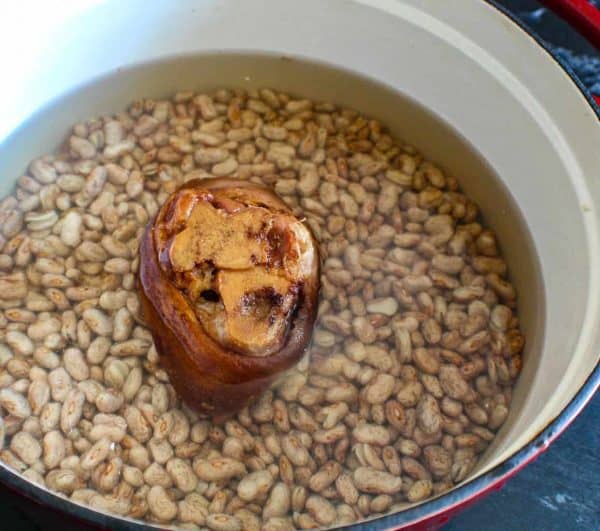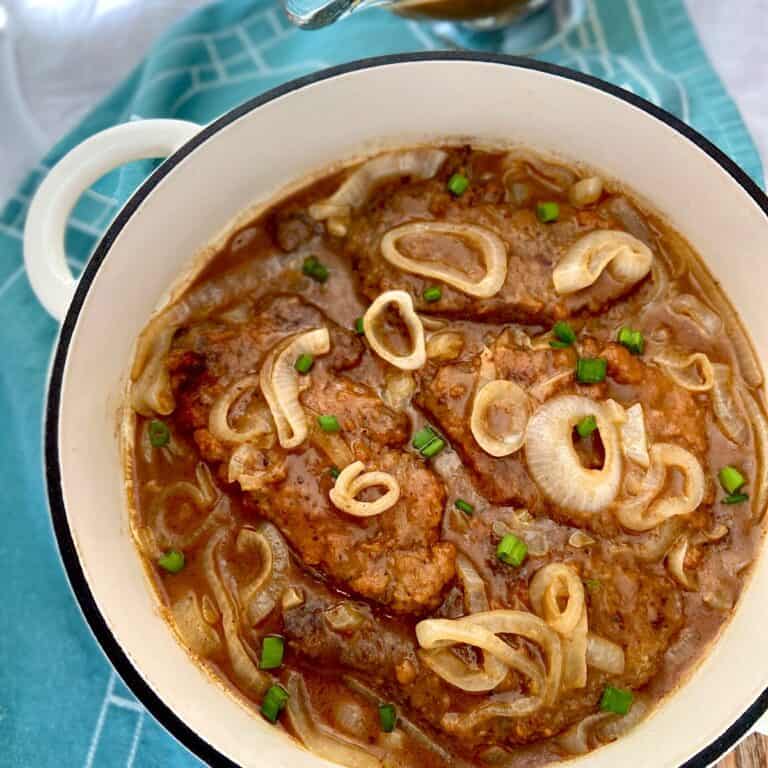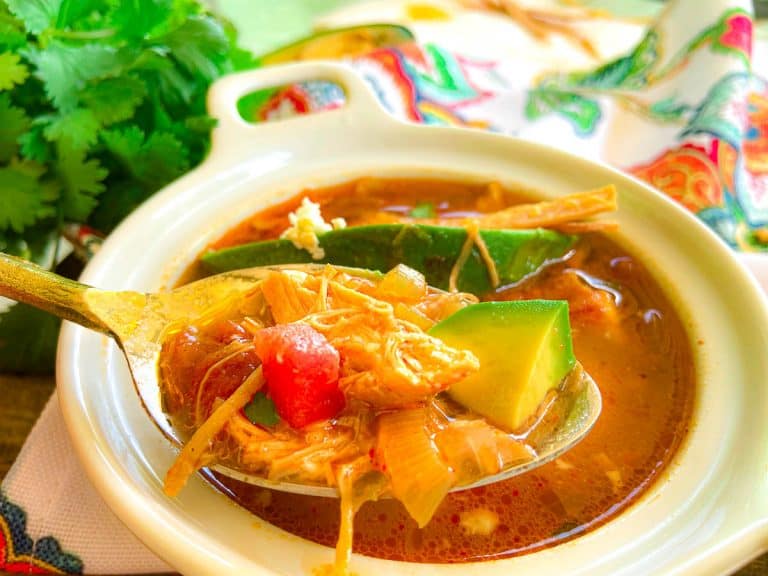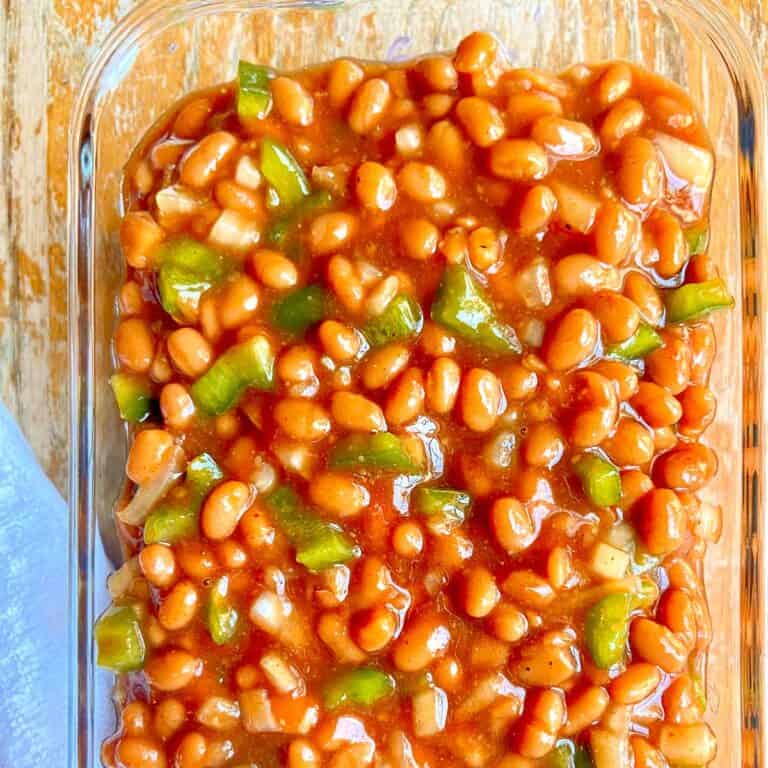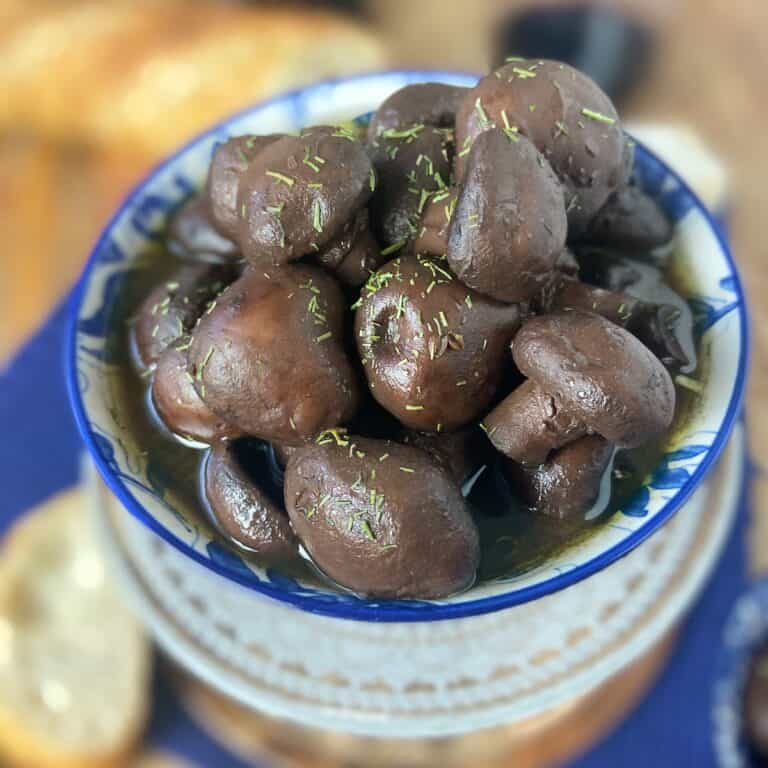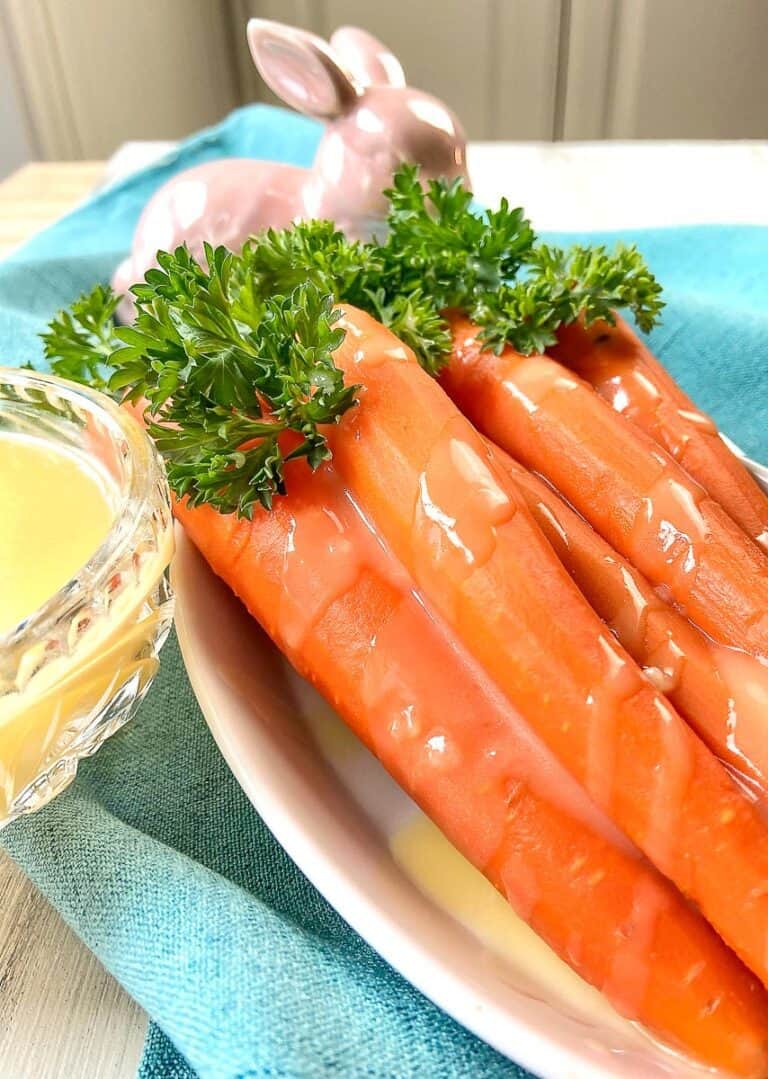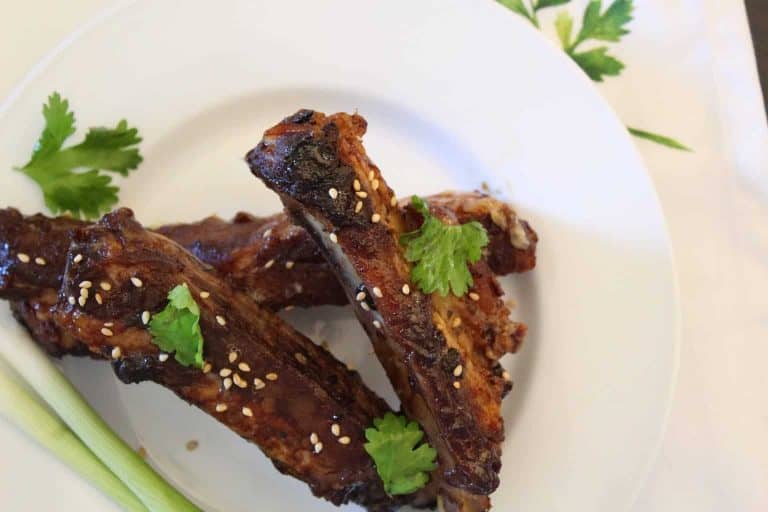Southern Pinto Beans and Rice
Once you learn how to make Southern Pinto Beans and Rice, you’ll never go hungry again! Here’s how to season and cook this classic Southern favorite comfort food!
This is a one-dish menu item you’ll find in every restaurant and home south of the Mason-Dixon Line.
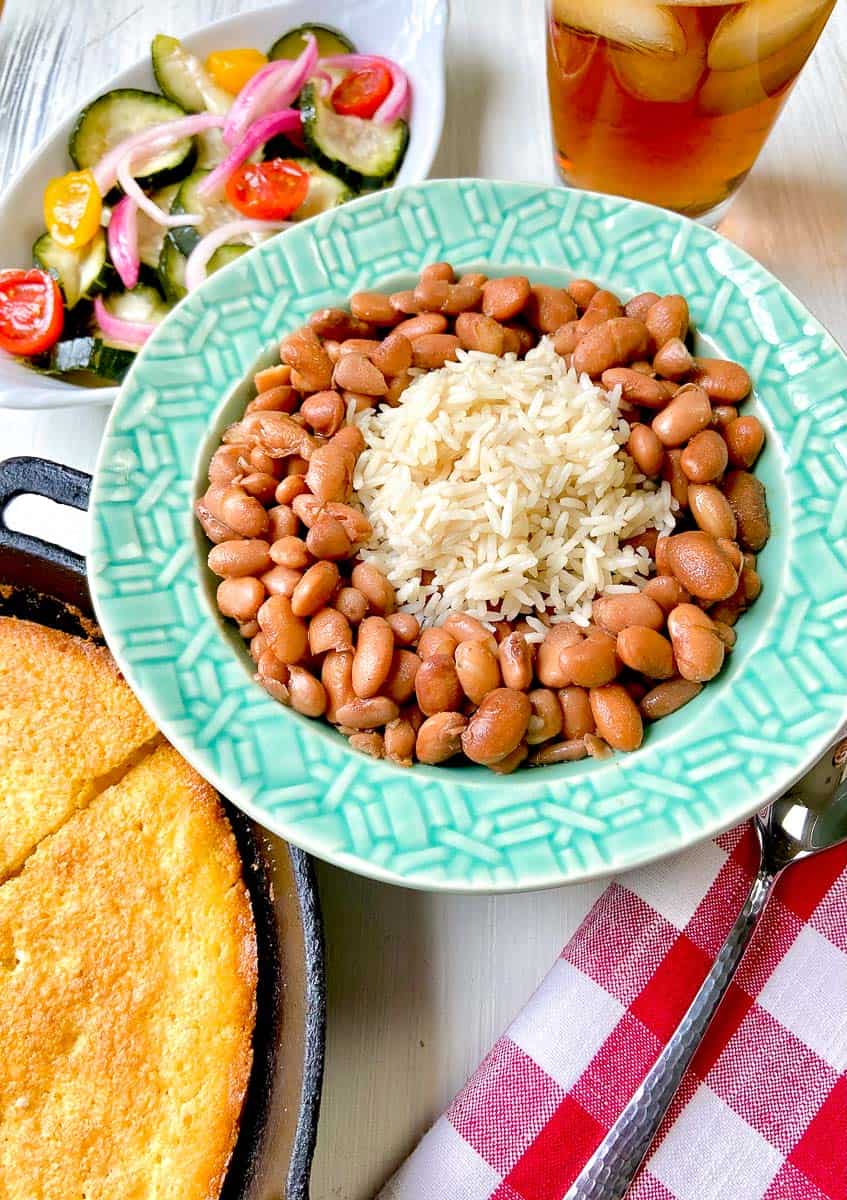
It’s delicious as a healthy, filling entree or side dish and is usually served with a side of cornbread, sweet onion and a glass of sweet tea.
In Louisiana, they use red kidney beans most of the time, but plain ole’ pinto beans work equally as well!
What type of beans should I use?
This recipe uses dry pinto beans, but you can use dry red kidney beans as well. The two have very similar nutritional and flavor profiles. I do not recommend using canned pinto beans for this recipe and method of cooking.
Kidneys are a little larger and more red in color than pinto beans and shaped like a kidney. Dried beans are found in bags-not cans-and are usually on the “beans and rice” aisle in the grocery store. You can use either type for this Southern Pinto Beans and Rice recipe.
How many cups does a pound of dried beans yield?
One cup of dried beans yields about 6 cups of cooked beans. So, if you’ve got a large group to feed, this Southern food is cheap!
Ingredients for pinto beans
Making a big pot of delicious beans doesn’t require anything fancy – simple ingredients work every time!
First and foremost, I recommend you use bottled water for soaking and cooking. The pH balance of the water is important and if you’re like most of us, we don’t know all that about our tap water so, bottled or distilled water is best.
Most Southern pinto bean and rice recipes call for some type of added fat, usually pork: bacon, smoked ham hock or ham. Some recipes include a few tablespoons of bacon grease. Any of these will work for seasoning.
The next ingredients are generally added: garlic and onion powder, salt and pepper, and sometimes a hint of smoky paprika.
You can buy a jar of “pinto bean seasoning” on the spice aisle, but it has silicon dioxide in it and I don’t know anyone who needs that in their beans.
Season the beans with salt and pepper last, especially if you use a salty pork product like bacon or ham.
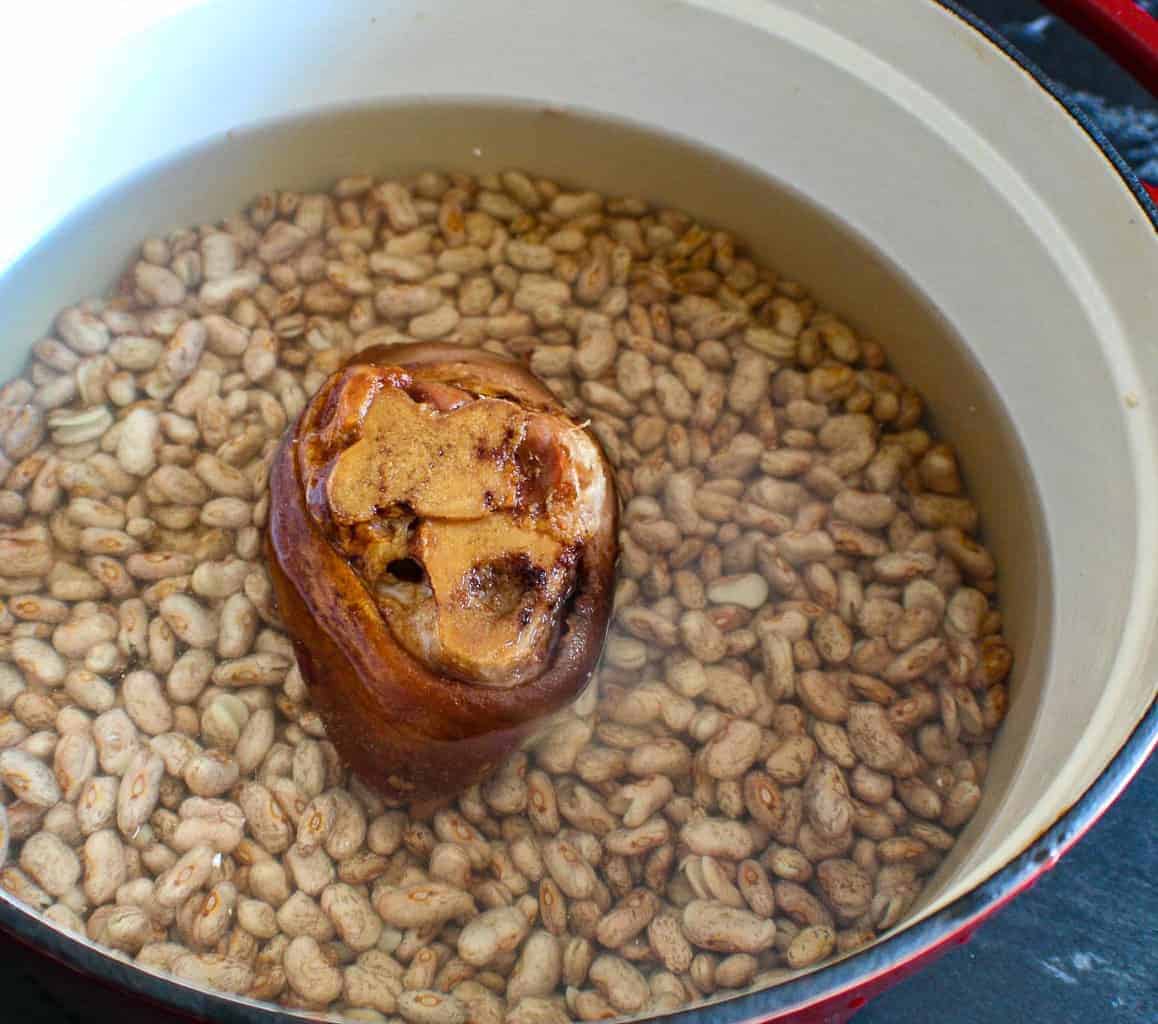
Add the fat to the beans at the beginning of the cooking process. As they slowly cook, the added fat cooks, too, resulting in a nice flavored pot of pinto beans.
Soaking methods
The key to the best bowl of pinto beans and rice is to make sure the beans are tender and flavorful. This is achieved by soaking the beans first in water.There’s two ways you can do this. The Overnight or the Quick Method.
Pinto and kidney beans require soaking and for best results, I recommend you soak them overnight (covered and on the counter- not in the fridge) in a lot of water with salt.
If you don’t have all night to soak the beans, do a quick “soak.”
Whichever method you use, you need to clean them first. Place dried beans in a colander and rinse under cool water; remove any rocks (yes! sometimes, there are little rocks in the bag!)
- Overnight Soak: Put the beans in a large bowl; add bottled water to cover the top of the beans by about 2 inches; add 2 tablespoons of table salt and cover with plastic wrap; let them soak overnight on the counter. Do not refrigerate the soaking beans. If you don’t have time to soak overnight, you can do what is called a “quick soak.”
- Quick Soak: Bring the beans and protein to a hard boil for 15 minutes in bottled/distilled water; turn the heat off of the stove, cover and allow beans to sit in water for 1 hour. After they’ve have rested, drain off the soaking water, (do not rinse) add beans and protein back to stockpot and cover with distilled water or broth. Note: no salt is added to the Quick Soak method when using a salty protein like pork; however if you do a quick soak with no salty protein, add 2 tablespoons of table salt to the stockpot.
How to make pinto beans
After cleaning and soaking, pour off any remaining soaking water, (do not rinse the beans), put them in a large pot, Dutch oven, slow or pressure cooker, and cover with fresh bottled/distilled water (or chicken broth, vegetable broth or beef broth) about 2 inches over the beans.
If you want to season with bacon or a smoked ham hock, add it to the water now. Add the fat to the beans at the beginning of the cooking process. As they slowly cook, the added fat cooks, too, resulting in a tasty broth and a nice flavored pot of pinto beans, Add in onion and garlic powder and allow beans to cook until tender.
(If you don’t have onion powder, you can add some sauteed onion – works just as well; same with garlic powder! Here’s how: in a medium skillet, add a little olive oil and bring it to medium heat; saute onion 5 minutes; add minced garlic, saute another minute, drain and add to pinto beans.)
Cook on low heat, uncovered for 2-4 hours, or until tender. Once tender, taste for salt and pepper.
I cook my beans low and slow so they won’t split. If you cook them uncovered, you might have to check the liquid level occasionally and add more water or broth if needed. You can put a lid on top of the stockpot -just put it ajar – so a little steam escapes. (I cook mine uncovered because I have an electric stove and the temperature isn’t consistent; it gets too hot and they start to boil over.
If you have a gas stove, it’s easier to control the stove temperature; in this case, putting a lid slightly ajar will work.
Once your beans and flavorful and tender, serve them over prepared white rice! Garnish with chopped green onions (optional) and serve with a side of homemade cornbread!
Liquids
You can use plain water, a vegetable, chicken or beef broth/stock as a cooking liquid. I recommend using bottled or distilled water and not tap water.
Beef and vegetable broths (or stocks) work well and give additional flavor, but keep in mind these usually contain a lot of sodium, so if you’re watching your sodium intake, use a “salt-free” or “reduced sodium” broth or stock.
Note, some of the broths and stocks on the market contain sugar. If you’re trying to limit your sugar intake, I recommend using Kitchen Basics™ chicken broth as it does not contain any added sugars
Cooking Methods for Pinto Beans
Most of the time, I cook my Southern pinto beans on the stovetop; it’s just what I’ve done for years.
Stovetop and slow cooker methods take the longest. The pressure cooker or “InstantPot™” cooks them the fastest.
Stovetop Method
In a large stockpot, add soaked dried beans, pork (optional) and 6-8 cups of liquid.
Bring to a rolling boil and allow to cook for 10-15 minutes; reduce heat to medium low, add seasonings (garlic powder, onion powder, black pepper) and allow to cook for 3-4 hours, uncovered, till tender.
Check the level of the liquid occasionally, and add more if needed. Once they’re tender, taste for salt; you’ll probably want to add more.
Slow Cooker Method
Add soaked beans, pork (optional), seasonings and 6-8 cups of liquid to slow cooker. Cook on medium 6-8 hours. Near the end of the cooking time, taste for seasonings and add more salt, if needed.
Instant Pot Method
- You can easily cook soaked or unsoaked dried beans in a pressure cooker. Just add your fat of choice, one pound of beans, seasonings and 8 cups of liquid. Lock the lid and cook on high.
- Cook unsoaked beans for 45-minutes and soaked beans for 20-minutes-both on “manual” or “pressure cook” mode.
- After the cooking time, let beans sit for 20 minutes, then do a quick release on the pressure cooker. Taste for seasonings and serve.
How to season pinto beans for vegans and vegetarians
When you cook rice and beans in water or vegetable broth, they are naturally vegetarian and vegan, but the flavor just isn’t “quite right.” (The Southern tradition of adding pork to them results in a non-vegetarian, but flavorful dish.)
You can mimic this smokey-fat-flavor by adding a few tablespoons of Liquid Smoke. Liquid smoke is gluten-free, has no additives or preservatives and is vegan.
It is usually found on the grocery aisle with the barbecue sauces. Add a few tablespoons near the end of the cooking process and you’ll have a flavorful pot of vegan rice and beans.
3 ways to eliminate gas from pinto beans
Some people prefer not to eat beans due to the side effects of the oligosaccharides–those pesky complex carbohydrates that can cause temporary digestive discomfort and gas. The best way to prevent gas is:
- Soak in lightly salted water overnight covered, on the counter, or
- Do a “quick soak” – bring to a rolling boil for about 15 minutes; let the beans rest in liquid, covered for an hour; return to low heat or simmer and cook until tender
- Take an over-the-counter formula like Beano® prior to eating beans; Beano® prepares the digestive system for the oligosaccharides and eliminate any gastric distress
When to salt
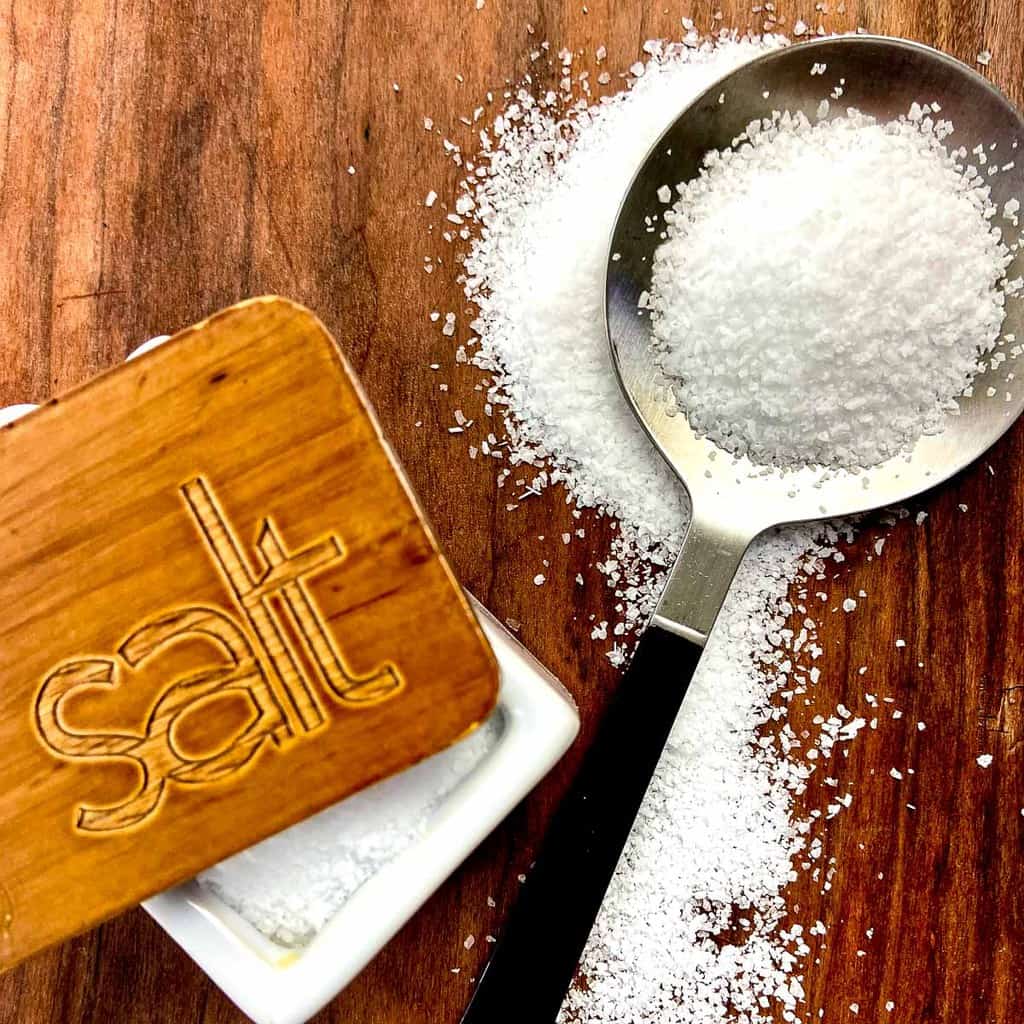
The most controversial issue regarding dried beans is when to add salt. Some say not till the end, others say at the beginning, and some say add salt in intervals.
The science behind this has to do with calcium and magnesium ions in the legume’s skin. Soaking in lightly salted water allows the salt to seep into the beans, replacing some of the ions, and resulting in a softer bean.
Conversely, soaking in unsalted water causes them to swell too fast and burst. So, the salt acts not only as a seasoning agent, but as a protectant for the skin.
Recipe FAQ
Split pinto beans can be due to a number of reasons:
You didn’t soak them in salted water – salt soaking water to prevent splitting
You cooked them too fast- cook them low and slow
The beans were old-here’s a couple of ways to determine if your beans are outdated or expired
The pH balance of your water was imbalanced – use bottled water for soaking and/or cooking
The most controversial issue regarding dried beans is when to add salt. Some say not till the end, others say at the beginning, and some say add salt in intervals.
The science behind this has to do with calcium and magnesium ions in the legume’s skin. Soaking in lightly salted water allows the salt to seep into the beans, replacing some of the ions, and resulting in a softer bean.
Conversely, soaking in unsalted water causes them to swell too fast and burst. So, the salt acts not only as a seasoning agent, but as a protectant for the skin.
If you accidentally get heavy-handed with the salt shaker and your pintos are too salty, just add more liquid–preferably water. (Broths and stocks usually have a pretty high sodium content.)
There are many theories as how to remedy over-salted foods, but adding water works every time.
The traditional rice used in this favorite Southern dish is long grain white rice, however brown rice is an excellent alternative and a healthier version.
Any type of rice works great in this dish, such as Jasmine or Basmati, but these rices have a different flavor than white or brown rice and alter the flavor profile of the dish. Cook the rice separately.
Bean Nutrition 101
Regardless of the method of preparation, a bowl of rice and beans is a complete protein with no fat, cholesterol or gluten. Safe for diabetics and good for everyone all the way around!
Fiber
Beans provide soluble and insoluble fiber, neither of which are digested or absorbed into the blood. Insoluble fiber moves quickly through the intestinal tract, balancing the pH levels and removing toxic waste.
Soluble fiber forms a gel when combined with liquid and binds to fatty acids; this prolongs the process of emptying the stomach, thus, sugar is released and absorbed more slowly.
Safe for Diabetics
Beans, or legumes, are complex carbohydrates and have a low glycemic index which means the natural sugars take longer to break down.
Since it takes longer for the soluble fiber to break down, blood sugar stabilizes and you feel full for a longer period of time.
Complete Protein
The combination of these two foods forms a complete protein. Without getting too academic, let’s just say that neither rice nor beans alone provide all the amino acids your body needs.
But when these two foods are eaten together, they provide essential amino acids, resulting in a “complete” protein.
Another way to look at it is: if you were stranded on an island and all you had to eat was rice and beans, you’d live.
Tips
- Use the freshest dried beans possible – most packages don’t have an expiration date, so use the dried beans shortly after you purchase them
- Use distilled/bottled water for soaking and cooking
- Add the salty protein (pork, ham hock, bacon) at the beginning of the cooking process to season the broth
- Cook the beans low and slow
- Add more liquid if necessary
- Add salt last
Recipe Variations
If your Northern friends won’t eat plain Southern Rice and Beans, consider dressing-up Southern pinto beans and rice with these options:
- Add a protein such as smoked sausage or cooked ground beef/turkey; this gives a hearty “American” spin to plain beans
- Add barbecue sauce, maple syrup or ketchup ; converts plain to “sweet barbecue”
- Want spicy beans? Add diced green chiles, a can of Rotel tomatoes, a pinch of chili powder and cilantro; this gives a “Southwestern/Mexican” flair
- Add diced, fresh jalapeno and top with sour cream for “Mexican” style rice and beans; serve over Mexican rice
In the Lone Star State, we eat pinto beans and rice with everything from fried catfish, homemade cream style corn, Southern greens and more!
Storage
Use an airtight container to freeze cooked pinto beans for up to 3 months. Pinto and kidney beans will expand in the freezer, so before you put them in the freezer, pour off a little of the juice and store it separately. (Don’t wanna waste that good bean juice!) Refrigerate in an airtight container for 3-5 days. After 5 days, they get mushy.
When it’s time to re-heat, I recommend using the stovetop – not the microwave. You may have to add a little water or broth because the pinto beans tend to thicken upon refrigeration. You may have to adjust the seasonings a bit.
More Southern recipes
Serve a bowl of Southern pinto beans and rice as a meal or as a side dish with one of these Southern Classics!
- Southern Cornbread
- Classic Meatloaf
- Southern Fried Catfish
- Southern Sweet Tea
- How to Season and Cook Purple Hull and Black Eyed Peas
- How to Season Southern Greens: Turnip, Collard, Mustard

If you make this recipe, please scroll down and leave a comment and rating! I love to hear from you!
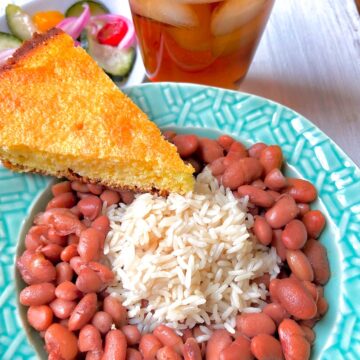
Southern Pinto Beans and Rice
Ingredients
- 1 lb. dried pinto beans
- 8 cups water or broth , most Southerner's use chicken or beef broth
- 2 tablespoons salt , for overnight soaking; table salt
- 2 tablespoons onion powder or 1 cup fresh, diced onion
- 2 tablespoons garlic powder
- 2 cups rice , brown or white rice, cooked
- 1 smoked hamhock (optional)
- salt and pepper to taste
Instructions
Quick Soak Method
- Rinse and drain beans
- Place beans in a large Dutch oven on the stove top; add enough liquid to cover by 2 inches; boil for 15 minutes, turn off the heat and put a lid on; let them sit for about an hour1 lb. dried pinto beans, 8 cups water or broth
- After one hour add onion, garlic and 1 teaspoon of black pepper and bring the beans back to simmer or low heat and cook until tender, uncovered; additional water or broth may need to be added during the cooking process; taste for seasonings and adjust accordingly2 tablespoons onion powder, 2 tablespoons garlic powder
Overnight Soak Method
- Rinse and drain beans; place them in a large bowl, add 2 tablespoons salt, add enough liquid to cover the beans by 2 inches; cover bowl with plastic wrap and allow beans to soak overnight on the counter1 lb. dried pinto beans, 2 tablespoons salt

- The next day, drain the beans; do not rinse
Stove Top Method
- Put beans in large Dutch oven with onion and garlic powder, liquid and protein (optional). Cook on low heat, uncovered, for 3-4 hours or until tender; check liquid level frequently; add more if needed; when tender, taste for seasonings and adjust accordingly1 lb. dried pinto beans, 8 cups water or broth, 2 tablespoons onion powder, 2 tablespoons garlic powder, 1 smoked hamhock
Slow Cooker Method
- Place soaked beans in slow cooker; add garlic and onion powder, protein (optional) in slow cooker and cover with water or broth; cook on medium 6-8 hours; season to taste with salt and pepper
- Pressure Cooker Method
- Add soaked or unsoaked beans, protein (optional), garlic and onion powder and 8 cups of water or broth in pressure cooker
- Set Pressure cooker to "manual" or "pressure cook" and cook on high for 45 minutes (unsoaked beans) or 20 minutes (soaked beans.)
- After the cooking time, let pressure cooker rest for 20 minutes; after 20 minutes, do a quick release on pressure cooker
- Taste for seasonings and serve.salt and pepper to taste
Rice Preparation
- Add water and rice to saucepan; bring to boil2 cups rice
- Reduce heat to simmer, cover rice and simmer until rice is fluffy

